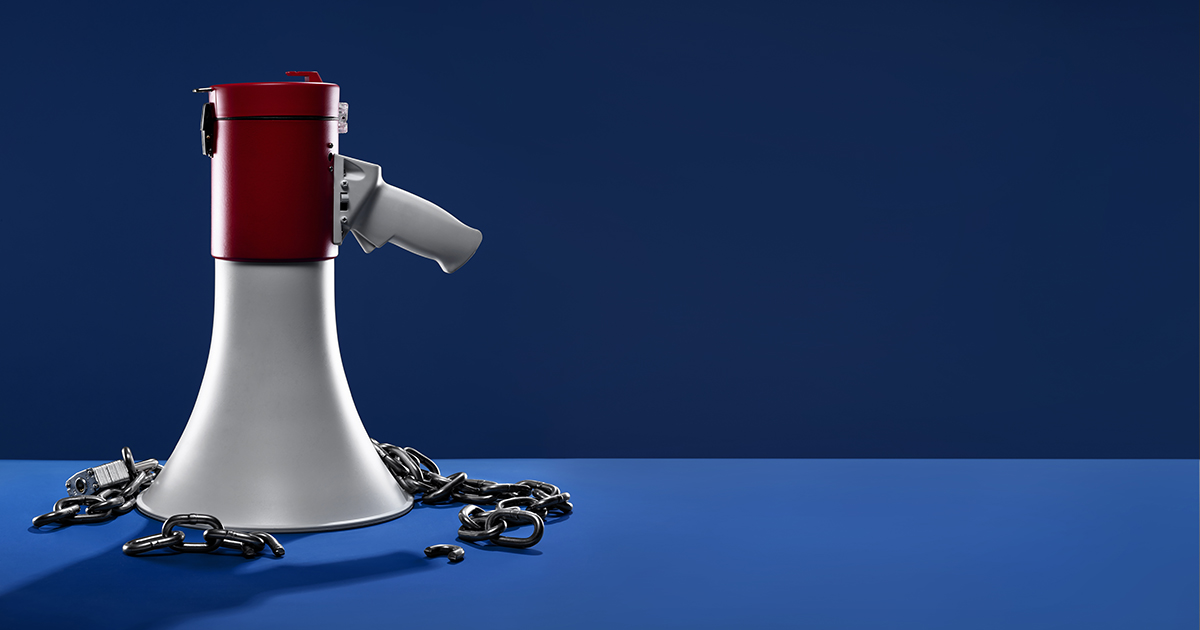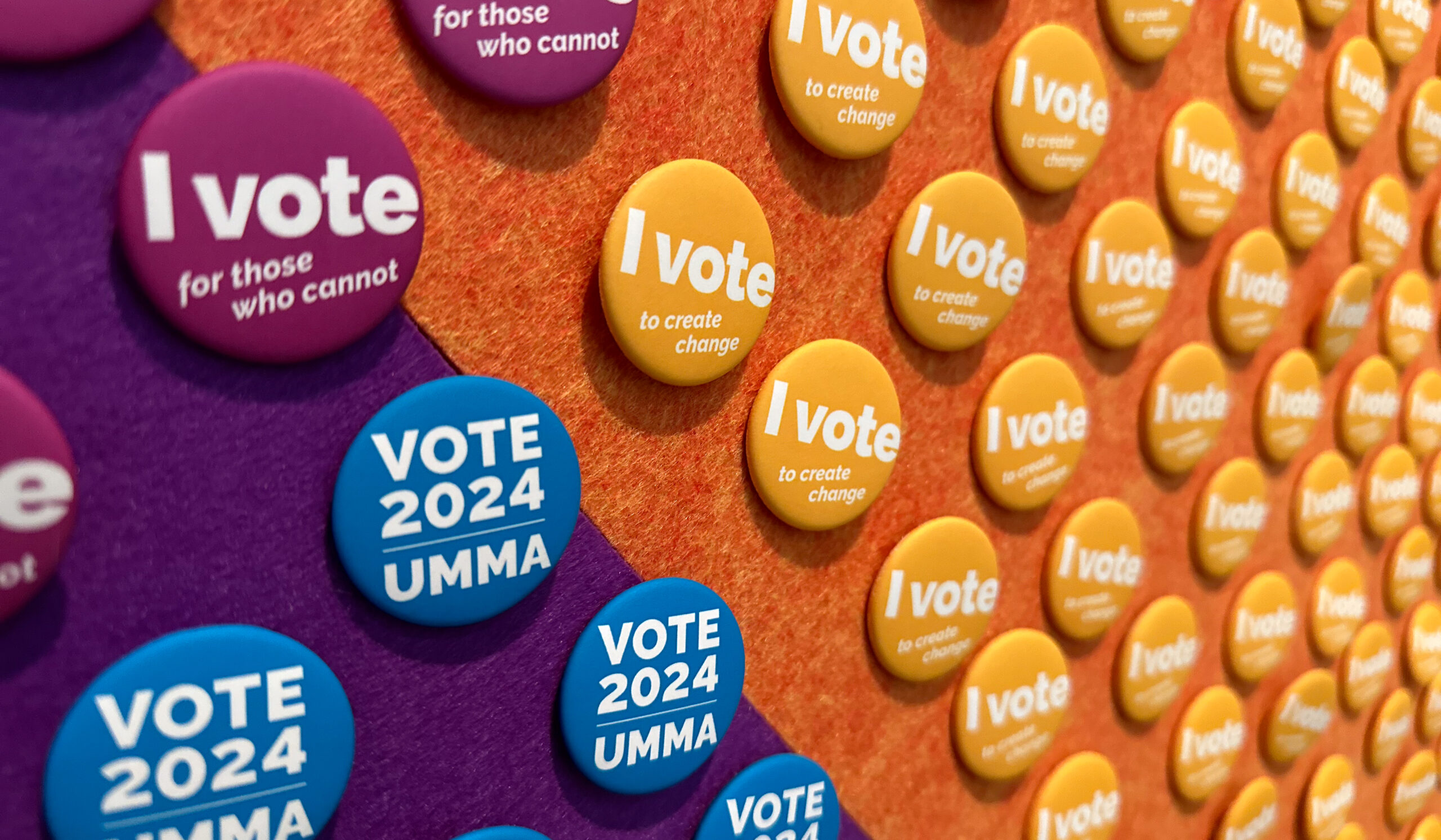Along with many colleges and universities across the country, U-M is debating issues of free speech on campus. Challenging questions offer no simple answers, but they do offer the opportunity for community engagement.
Last October, controversial social scientist Charles Murray visited campus at the invitation of the U-M chapter of the College Republicans and the American Enterprise Institute U-M Executive Council. He came to discuss his latest book, but students and faculty familiar with his earlier book, “The Bell Curve” (in which he equates IQ with race and social class), protested his visit.
Despite large numbers of protestors, police allowed only the first 200 people into the room at Palmer Commons. Once inside, however, the group activated smartphone alarms, read statements against him, and even projected the words “White Supremacist” on the wall. Only when they walked out was he able to finish uninterrupted. Unlike March 2017, when Murray spoke at Middlebury College in Vermont, there were no violent clashes.
Fast forward to Feb. 15, when two U-M students on opposing sides of the Murray event discussed the issue during a panel on free speech at Rackham Auditorium.
U-M graduate student Maximillian Alvarez, the co-founder of the Campus Antifascist Network, said he protested that day to make his voice heard and not allow Murray’s presence on campus to go unquestioned. Then-senior Jessie Arm, ’17, one of the organizers of Murray’s visit, countered Alvarez, ‘’If the University is huge on safe spaces, the biggest safe space is the right to free speech.” He had hoped Murray’s visit would provide a forum for an exchange of ideas.
Such tensions surrounding issues of free speech are manifest today on many campuses. While colleges and universities strive to be open to all ideas, they also strive to provide a safe and inclusive environment for students. At U-M, the conversation surrounding free speech didn’t end with Murray’s visit. (See page 19.) In the intervening months, the administration, board of regents, students, faculty, and staff have debated a request by white nationalist Richard Spencer to rent a facility for an appearance in Ann Arbor. (He will not come to campus this academic year, but the University may have to consider his request later in 2018.)
“What we hear today is an energetic and important debate about how to reconcile our goal of having a campus where ideas can be freely expressed with our goal of having a campus that is welcoming, inclusive, and nondiscriminatory,” says Len M. Niehoff, ’81, JD’84, a First Amendment scholar and professor at the U-M Law School.
One key argument of those who oppose Spencer’s visit is the possibility of physical harm, which occurred in Charlottesville, Virginia, when he appeared there in August. Violent clashes between his supporters and protesters resulted in the death of a protester; dozens were injured. That same month, 13 people were arrested in Berkeley when thousands of people gathered in what was supposed to be a peaceful march against bigotry. Instead, antifascist protesters, dressed in black with their faces covered, clashed with white nationalists. And closer to home, Spencer spoke on March 5 at Michigan State University, where multiple police agencies provided security. By the end of the day, there were 25 arrests, 13 on felony charges, and four police officers suffered minor injuries.
Like these other universities, U-M is a public—and therefore governmental—institution. So it must uphold First Amendment protections of free speech and not restrict people from campus based only on the presumed content of their speech.
“Unfortunately, we have no way of keeping Spencer from coming,” says Robert Sellers, vice provost for equity and inclusion, and the University’s chief diversity officer. “What we have to do is make sure our students and our community are as safe as possible.”
U-M President Mark Schlissel echoed that thought in a November 2017 letter to the U-M community following Spencer’s request to visit campus. “Let me repeat: If we cannot assure a reasonably safe setting for the event, we will not allow it to go forward.”
Alexa St. John, a U-M junior and editor of The Michigan Daily, agrees that the University should not allow speakers whose supporters might cause physical harm. The Daily uses that same standard in deciding whether to print opinion pieces. As long as an essay would not incite physical harm or threats to someone in particular, St. John says it is usually cleared for publication.
“Free speech is a core value of America, it’s part of what made us who we are,” St. John says. “But when there’s a correlation of danger attached to it, it’s my opinion and that of many students that we can’t allow it.”
Safety is not the only variable in the University’s decision whether to allow a speaker. It is important, Sellers says, for Michigan students as well as the broader community to hear various points of view, not simply those with which they agree.
“One of the goals is to make sure we as an institution do not lose what I think is a responsibility to help educate our students across differences.”
Not surprisingly, the atmosphere of hyper-partisanship that proliferates around the United States is infecting institutions of higher education, which are microcosms of the larger society.
“The country is going through an identity crisis, and Michigan is no different,” says senior Anushka Sarkar, president of U-M’s Central Student Government. “When people feel threatened, it’s difficult for them not to retract into what feels safe and affirming. That worries me.”
In the end, Sellers says the University faces a greater task than deciding who can rent a microphone or which views can be expressed in a classroom.
“Can we get to a point where we treat each other with a level of respect and civility that allows differences in ideas?” he asks. “The biggest problem we face is understanding that, just because I have the right to say it, doesn’t mean it is right to say it.”
To provide a forum for dialogue on these issues, U-M’s office of Diversity, Equity & Inclusion and other campus units, including the Alumni Association, are sponsoring Speech and Inclusion: Recognizing Conflict and Building Tools for Engagement. This series has offered various events on campus this semester, including “Speak Freely,” the Feb. 15 event at Rackham moderated by NPR’s Joshua Johnson; “Free Speech and the Necessity of Discomfort,” a presentation by conservative New York Times columnist Bret Stephens; and a keynote speech by journalist April Ryan at the U-M Women of Color Task Force conference.
In addition, the Office of Academic Innovation has organized several teach-outs, a series of online courses focused on free speech on campus, in journalism, and in sports. And on March 15, the University held a teach-in for the campus community to discuss building an inclusive movement against white supremacy and racism.
During his presentation, New York Time’s columnist Stephens said it was important for both sides to engage in dialogue and admit that their firmly held opinions could be wrong.
“We are rapidly losing the ability to talk to one another,” Stephens said. “What we lose by trying to censor hate speech is infinitely greater than what we gain by allowing hate speech to manifest itself.” He warned that what Spencer and his provocative counterparts want most is to be called martyrs—silenced because they pose too big a threat.
Jesse Arm, who helped organized the Charles Murray visit and participated in the Feb. 15 panel, suggested that the best reaction to Spencer—who is neither invited nor sponsored by anyone in the U-M community—is to ignore him. “I don’t want Spencer here on campus, but I think the strongest sign would be for him to speak to an empty classroom or an empty Rackham auditorium.” However, it’s difficult to ignore someone like Spencer.
“They bring violent people with them who storm our towns and believe in ethnic cleansing and apartheid,” counters Maximillian Alvarez, who also participated in the Feb. 15 panel. “It is a slippery slope, but should it be called free speech when it is a threat to our community?”
This is not the first time that U-M has been embroiled in free speech debates. Sellers says that students are acting in the same way that students have acted historically. Protests against the Vietnam War most likely would not have taken place without the activities of Students for a Democratic Society, which was founded at Michigan in 1960 to promote equality, economic justice, peace, and participatory democracy. Along with other student-led organizations such as the Student Nonviolent Coordinating Committee, SDS was one of the proponents of the civil rights movement. Both organizations might have been stifled if there had been no policies on college campuses to promote free speech.
“Free speech cases are almost never about popular speech or speech that represents the majority view,” Niehoff says, noting that U.S. Supreme Court Justice Louis Brandeis, the court’s first Jewish justice, wrote frequently about the First Amendment and the need for civic courage. “We are being asked to have a lot of it at present—particularly those who are members of groups targeted by hateful speech and noxious ideologies.”
In the late 1980s, the campus was rattled by a series of incidents, including a racist flier, repeated destruction of a student-built hut that protested apartheid in South Africa, display of a Ku Klux Klan uniform from a dorm room window, and a guest on student-run radio station WJJX who told racist jokes, causing the station to be shut down.
In response to these incidents, the University adopted a free speech policy in 1988 that was meant to define and curb hate speech. But the effort was immediately challenged in court by an unnamed graduate student, in a case called Doe v. University of Michigan, as being vague and overbroad. After the U.S. District Court for the Eastern District of Michigan struck down the policy, the University rewrote it and put the new guidelines into effect in 1993. It still abides by the policy (see sidebar below).
“Writing a code that prohibits harmful and unprotected speech sounds easy enough,” says Niehoff, who was on campus when that debate was underway. “But such a code must be sufficiently specific that people know what they can and cannot do, sufficiently narrow that it does not overreach and punish protected speech, and sufficiently detailed that it does not leave administrators with unbridled discretion.”
As the University community continues to debate and discuss free speech issues, it’s obvious that no simple answers exist for some very challenging questions. In his November letter, Schlissel indicated that the community can draw together despite the challenges.
“We now face a very difficult test of our ability to uphold these values. This is a test we did not welcome, but it’s one that we must face together.”
FREEDOM OF
SPEECH
AND ARTISTIC
EXPRESSION
The University issued a free speech policy in 1988 and updated it in 1993. Following is the introduction to the current policy. For the list of 13 guidelines, visit spg.umich.edu/policy/601.01.
Recent events at the University of Michigan and elsewhere emphasize the pressing need for members of the University community—including administrators, faculty, staff, and students—to reaffirm formally their deep commitment to freedom of speech and artistic expression and to clarify the implications of that commitment. Freedom of speech in this context will be taken to encompass all forms of communication and artistic expression as well as the freedom to listen, watch, protest, or otherwise participate in such communication. It is hoped that this reaffirmation will win the support, in spirit and in letter, of people representing the entire spectrum of opinion of the University community in order to create a truly open forum, one which diverse opinions can be expressed and heard.
Expression of diverse points of view is of the highest importance, not only for those who espouse a cause or position and then defend it, but also for those who hear and pass judgment on that defense. The belief that an opinion is pernicious, false, or in any other way detestable cannot be grounds for its suppression.
When a speech or some form of artistic expression such as a play or concert is prevented by disruptive protest from taking place or concluding, the effect is just as surely an attack on freedom of speech or artistic expression as the deliberate suppression or prohibition of a speaker or artist by authorities. At the same time, however, the rights of free expression enjoyed by speakers or performers do not negate the rights of free expression of those who would protest the speech or performance.
The guidelines that follow concern how most fully to protect rights of free expression for speakers, performers, and protesters alike.
They apply to settings in which an audience has been assembled for a talk or performance, or in which a talk or performance takes place in a public setting at the University, but do not apply to the classroom. They are not general guidelines concerning freedom of expression among individuals or in other University settings where protest might occur. Moreover, they do not cover acts of physical violence, or verbal harassment or threat directed at individuals in which there is no intent to communicate publicly or with a wider audience. Nor do these guidelines in any way restrict the application of civil or criminal law. Finally, these are not guidelines concerning appropriate or civil conduct at speeches or artistic performances. Rude or offensive behavior, though inconsistent with the standards of civility that we hope would prevail on a university campus, sometimes falls within the legitimate exercise of freedom of speech and, when it does, may not be suppressed.
These guidelines apply to members of the University community (students, faculty, staff, and administrators) and to their invited guests. By following these guidelines we seek to maintain at the University an environment in which the free exchange of opinions can flourish, where the learning that such exchange makes possible can occur. We welcome members of the broader public to participate in this free exchange, and we expect those who do to observe the limits of mutual tolerance embodied in these guidelines.
With these qualifications in mind, the Civil Liberties Board of the Senate Assembly recommends to the University community endorsement and adoption of the following guidelines pertaining to freedom of speech and artistic expression.
Micheline Maynard, a Knight-Wallace fellow at U-M in 1999-2000, is a regular contributor to Michigan Alumnus.





